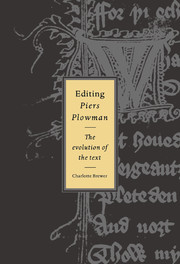Book contents
- Frontmatter
- Contents
- Acknowledgements
- Abbreviations
- Note on the texts
- Introduction
- Part I The early phase
- 1 Crowley
- 2 Percy, Warton, Tyrwhitt, Ritson
- 3 Whitaker and Price
- 4 Wright
- Part II The late nineteenth century
- Part III The Skeat aftermath
- Part IV Chambers and Grattan, Knott and Fowler
- Part V The Athlone Press edition
- Part VI Epilogue: the Athlone aftermath: Schmidt, Pearsall, Rigg-Brewer, et al.
- Works cited
- General index
- Index of manuscripts
- CAMBRIDGE STUDIES IN MEDIEVAL LITERATURE
3 - Whitaker and Price
Published online by Cambridge University Press: 20 August 2009
- Frontmatter
- Contents
- Acknowledgements
- Abbreviations
- Note on the texts
- Introduction
- Part I The early phase
- 1 Crowley
- 2 Percy, Warton, Tyrwhitt, Ritson
- 3 Whitaker and Price
- 4 Wright
- Part II The late nineteenth century
- Part III The Skeat aftermath
- Part IV Chambers and Grattan, Knott and Fowler
- Part V The Athlone Press edition
- Part VI Epilogue: the Athlone aftermath: Schmidt, Pearsall, Rigg-Brewer, et al.
- Works cited
- General index
- Index of manuscripts
- CAMBRIDGE STUDIES IN MEDIEVAL LITERATURE
Summary
In 1813, after a gap of over two hundred and fifty years, the second major edition of the poem was published in an impressive black-letter folio edition. Its editor, Thomas Dunham Whitaker (1759–1821), was a Lancastrian vicar, one of whose claims to fame was a fascination with trees (he planted a forest and had his coffin fashioned from a particularly notable specimen), and whose other published output, apart from an edition of Pierce the Ploughman's Crede prepared from the 1553 edition, comprised distinguished works of topography. Whitaker's volume is far closer to what we would now recognise as a scholarly edition of the poem. The difference between his attitude to his edition and that of Percy and Warton is clear: there has been a signal shift in literary sensibilities in the last forty years. Whitaker feels no need to argue for the importance of medieval literature generally, either for its own sake or for its illumination of the editor's contemporary society. He shows a more detailed knowledge and grasp of the historical circumstances in which the poem was composed, and his orientation is more literary than that of his predecessors.
In his substantial Introductory Discourse, Whitaker sets out to explain what he regards as the principal literary characteristics of Piers Plowman – the predominance of satire on the one hand, and allegory on the other – in terms of the historical circumstances of both poet and poem. He sees the reign of Edward III, during which the poem was at least partly composed, as a time of corruption and decline, and hence an effective instigator of satirical literature.
- Type
- Chapter
- Information
- Editing Piers PlowmanThe Evolution of the Text, pp. 37 - 49Publisher: Cambridge University PressPrint publication year: 1996

